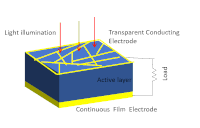Solar-cell efficiency

Okay, let's talk about solar-cell efficiency! Imagine you have a toy car that needs energy to move. One way to give energy to the car is by using a battery. The battery has a certain amount of energy, and when it runs out, the car stops moving.
Now, imagine if we could use something called solar cells to power the toy car instead. Solar cells are like tiny little devices that can take energy from the sun and turn it into electricity. They have some special materials inside that can do this.
But not all solar cells are the same. Some are more efficient than others. Efficiency is a fancy word that tells us how good something is at doing its job. In this case, it tells us how good the solar cell is at turning sunlight into electricity.
Let's say we have two solar cells, A and B. Cell A is 20% efficient, and cell B is 30% efficient. This means that for every 100 units of sunlight that hit both cells, cell A can convert 20 units into electricity, and cell B can convert 30 units into electricity.
So, cell B is more efficient because it can convert more sunlight into electricity. This is like having a toy car that can move faster and longer because it gets more energy from the sun.
Scientists are always trying to make solar cells more efficient because that means we can get more electricity from the same amount of sunlight. They use different materials and technologies to improve efficiency. Some solar cells even have multiple layers to capture different types of sunlight, making them even more efficient!
When solar cells become very efficient, it means that we can generate more electricity from the sun, which is a good thing. Solar energy is clean and doesn't produce pollution, so it's important to use it as much as we can.
Remember, solar-cell efficiency is just a way to measure how good a solar cell is at turning sunlight into electricity, making it like having a super-powered toy car that never runs out of energy!
Now, imagine if we could use something called solar cells to power the toy car instead. Solar cells are like tiny little devices that can take energy from the sun and turn it into electricity. They have some special materials inside that can do this.
But not all solar cells are the same. Some are more efficient than others. Efficiency is a fancy word that tells us how good something is at doing its job. In this case, it tells us how good the solar cell is at turning sunlight into electricity.
Let's say we have two solar cells, A and B. Cell A is 20% efficient, and cell B is 30% efficient. This means that for every 100 units of sunlight that hit both cells, cell A can convert 20 units into electricity, and cell B can convert 30 units into electricity.
So, cell B is more efficient because it can convert more sunlight into electricity. This is like having a toy car that can move faster and longer because it gets more energy from the sun.
Scientists are always trying to make solar cells more efficient because that means we can get more electricity from the same amount of sunlight. They use different materials and technologies to improve efficiency. Some solar cells even have multiple layers to capture different types of sunlight, making them even more efficient!
When solar cells become very efficient, it means that we can generate more electricity from the sun, which is a good thing. Solar energy is clean and doesn't produce pollution, so it's important to use it as much as we can.
Remember, solar-cell efficiency is just a way to measure how good a solar cell is at turning sunlight into electricity, making it like having a super-powered toy car that never runs out of energy!
Related topics others have asked about:
